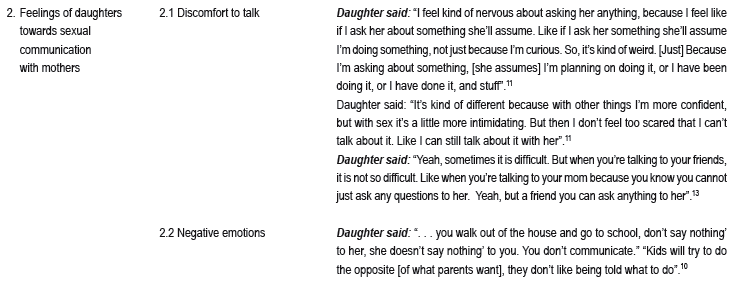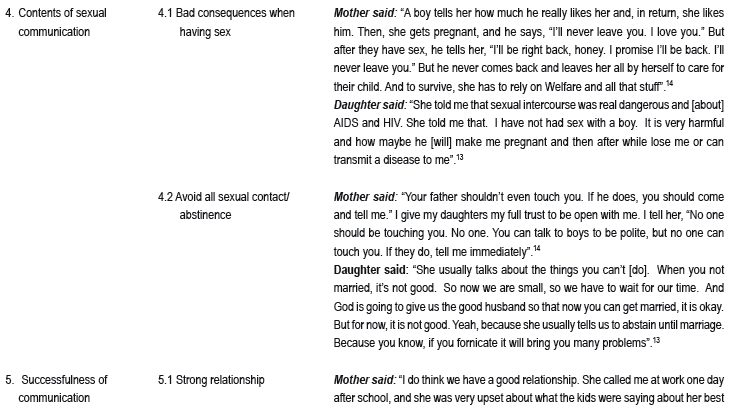Premarital sex is associated with negative and positive consequences. Sex in adolescents has more negative than positive consequences. If adolescents fail to use birth control, adolescents become pregnant, which increased the rates of unintended pregnancy, as well as an increased risk of HIV infection and other sexually transmitted infections (STIs).1,2 Results from previous studies reveal that most parents tend to talk with their adolescents only about certain aspects of physical and reproductive development, such as menstruation and nocturnal emissions; however, discussion about other sexually related issues is limited. According to the study, they believe that talking about these issues will encourage sexual activity. They also believe that their children are too young, and need to concentrate on their studies, therefore adolescents are expected to delay sexual involvement, and they are encouraged to wait for the ‘right time,’ or until they are mature enough. Moreover, parents’ lack of confidence, lack of communication skills and embarrassment are frequently cited as barriers inhibiting parents from talking openly about sexual issues with their children.2-4 These problems of discussion about sexual matters with parents are related to risky sexual behaviors among adolescents.
Traditionally in Thailand, it is considered inappropriate to discuss sexual issues openly and directly. Consequently, adolescents may not be comfortable in speaking about sex with their parents and may rely on other sources of information regarding sexuality, such as the internet, media, friends, books and magazines. Often adolescents draw misunderstandings from these sources.5 These misunderstandings are a barrier to preventing negative consequences of sexual activity in adolescents. Sex education should not be limited only to school, the family also has a role to play. For the development of social skills that can be effective in the avoidance of negative outcomes and the reduction of dangerous sexual behaviors by adolescents, sexual education can be extremely helpful.6 In most cases, adolescents do not feel at ease about talking to their parents about sex-related topics. Particularly among female adolescents, the evidence makes it apparent that mothers are the primary influence in the lives of daughters. Mothers are much more likely than fathers to have frank discussions about sex and wellbeing with their adolescent daughters.7,8 Increased risk of negative sexual behaviors and activity among adolescent females can be directly linked to the lack of communication between mothers and daughters about sex.Therefore, mothers should advise their daughters on proper sexual expression to prevent sexual abuse, raise self-esteem and develop negotiating skills. Teaching about sexuality at this point should be undertaken to help daughters better understand female sexuality, delay sexual initiation and prevent other negative consequences of sexual activity in female adolescents.
The expected outcome for effective information concerning these aspects can be used by qualitative research, which can also create intervention programs. Certainly, integration of the findings from qualitative studies is required so as to notify policy making.9
The purpose of this study is to understand the communication about sex between mothers and their adolescent daughters by conducting an integrative review of qualitative studies. Our specific goals were to identify relevant studies; synthesize and identify common themes across studies; and inform an effective communication program about sex education for adolescent women.
Systematic literature searches were carried out on electronic databases: CINAHL; MEDLINE; PubMed database; and the Cochrane library for journal articles and doctoral dissertations with full text, using key terms including “mother-daughter communication”, “mothers and their adolescent daughter’s communication”, “communication about sex”, and “sexual communication”. All databases were searched to identify qualitative studies published between 2000 and 2017. The following inclusion criteria were applied: 1) Primary source with full text, 2) Involved discipline of nursing, 3) Identified “Mother-adolescent daughter communication about sexuality” within the title or context of the abstract, 4) came from qualitative studies, 5) be published in English and 6) be published between 2000 to 2017. The screening and selection process is illustrated in Figure 1. Articles meeting criteria were reviewed in their entirety. Data was synthesized using thematic analysis.

Figure 1: The screening process of systematic literature search.
A total of seven studies were included in the review. Key characteristics of the seven studies in integrative review are shown in Table 1. There have been many studies about communication about sex between mothers and their adolescent daughters in a variety of countries and each study used a different collection method, such as: Focus groups, Participatory Action Research, Semi-structured interviews, and In-depth interviews.
Table 1: List of included articles

Table 2 demonstrates typical statements from primary studies were categorized by themes and concepts. Five themes emerged from these studies: 1) Mothers’ attitudes towards talking about sex with their daughters, 2) Feelings of daughters towards sexual communication with mothers, 3) The first time to talk, 4) Contents of sexual communication, 5) Successfulness of communication. These themes include details as follows:
Theme1, “Mothers’ attitudes towards talking about sex with daughters”, consisting of 6 concepts: A daughter should have no secrets, Discomfort to talk, Fear, Necessary topic, Lack of sexual communication skills, and Lack of time. Theme 2, “Feelings of daughters towards sexual communication with mothers” consisted of 3 concepts: Discomfort to talk, Negative emotions, and Necessary topic. Theme 3, “The first-time mother starting to talk about sex with her daughter” consisted of 3 concepts: Started puberty, Daughter interested in boys, and Right Opportunity. Theme 4, “Contents of sexual communication” consisted of 2 concepts: Bad consequences when having sex and Avoid all sexual contact/abstinence. Finally, theme 5, “Successfulness of communication” consisted of 5 concepts: Strong relationship, Mothers’ knowledge, Comfort to talk, Privacy, and Respect for cultural and religious beliefs.
Table 2: Typical statements by themes





The findings provide insight into the important roles that mothers play, a significant role in sexual communication with their adolescent daughters, and suggest scope for future research and the development of sexual communication interventions. The main results in this study shown that there were five important themes: mothers’ attitudes towards talking about sex with daughters; feelings of daughters towards sexual communication with mothers; the first-time mother starts to talk about sex with her daughter; contents of sexual communication and successfulness of communication. The results from this review found that both mothers and daughters place emphasis on sexual communication as necessary but find it difficult to talk. Sexual education is therefore particularly important and is needed to assist female adolescents in developing social skills which can be used to avoid negative consequences and reducing risky sexual behaviors.6 Therefore, communication about sexuality between mothers and their adolescent daughters could be improved and encouraged by open, direct and receptive communicating styles covering a wide range of sexual topics. Moreover, mothers’ lack of sexual communication skills is a barrier inhibiting mothers from talking openly about sexual issues with their adolescent daughters. Teaching about sexuality should be undertaken to help daughters better understand female sexuality, delay sexual initiation and prevent other negative consequences of sexual activity in female adolescents.16
In addition, the results found that the first time in which the mother started talking about sex with her daughter was when her daughter stated puberty, became interested in boys and had the right opportunity. Therefore, when their daughters start puberty, mothers should begin to prepare them for bodily changes and to understand the outcomes. Mostly, this is the time when mothers begin to discuss sexuality with daughters. They begin when they recognize physical changes in their daughter, or when their daughter informs them of changes such as bleeding from the vagina or enlarged breasts.12 Mothers should use this opportunity to instruct their daughters on proper sexual expression to prevent sexual abuse, raise self-esteem and develop negotiating skills. To ensure the successfulness of communication about sexuality between mothers-adolescent daughters, future studies should be designed to provide knowledge and develop skills for mothers to communicate about sexuality to their adolescent daughters, with emphasis on comfort to talk, privacy, strong relationship between mothers and daughters, and respect for cultural and religious beliefs in each country.
Our findings provide a better understanding of the communication about sexuality between mothers and their adolescent daughters, which could inform policy in planning future programs to develop mother’s skills in communication about sexuality with adolescent daughters.